Winning projects of the 2014 U.S. Wood Design Awards
By Bustler Editors|
Friday, Mar 28, 2014

Related
The winners of the WoodWorks 2014 U.S. Wood Design Awards sure know how to prove wood as a versatile material in architecture. Out of 140 entries -- the most the competition has ever received -- the jury selected nine of the most outstanding projects in wood architecture.
During the recent ceremony at the Southeast Wood Solutions Fair in Charlotte, NC, awards were given in categories including: Institutional Wood Design, Wood School Design, Commercial Wood Design, Multi‐Story Wood Design, Beauty of Wood, Green Building with Wood, Traditional Use of Wood, Innovative Wood Engineering, and Jury’s Choice.
Four Regional Excellence Awards were also given.
Check out the winning projects below.
Institutional Wood Design: James and Anne Robinson Nature Center in Columbia, MD
Architect – GWWO, Inc./Architects
Engineer – Faisant Associates, Inc.
General Contractor – Forrester Construction
Project description: "The 26,00 square foot Robinson Nature Center features a 50-seat planetarium, exhibits, classrooms, an auditorium and offices. Given the Center's role of connecting visitors with nature, it was important that the structure appear modest on approach and in keeping with its setting, while minimizing impacts on the site. The exterior cedar siding blends with the natural landscaping, making it aesthetically pleasing while allowing nature itself to remain the focal point. The roof system includes a tongue and groove wood deck carried by timber purlins that span between large glulam girders left exposed in the main space. Inside, ash acoustical wall slats and oak flooring create rich, warm tones. Achieving LEED Platinum certification was of paramount importance to the client as its mission is to educate the public about environmental stewardship. By specifying wood that was either FSC-certified, low-emitting, recycled and/or regionally produced, seven LEED points were gained, helping this goal to be met."
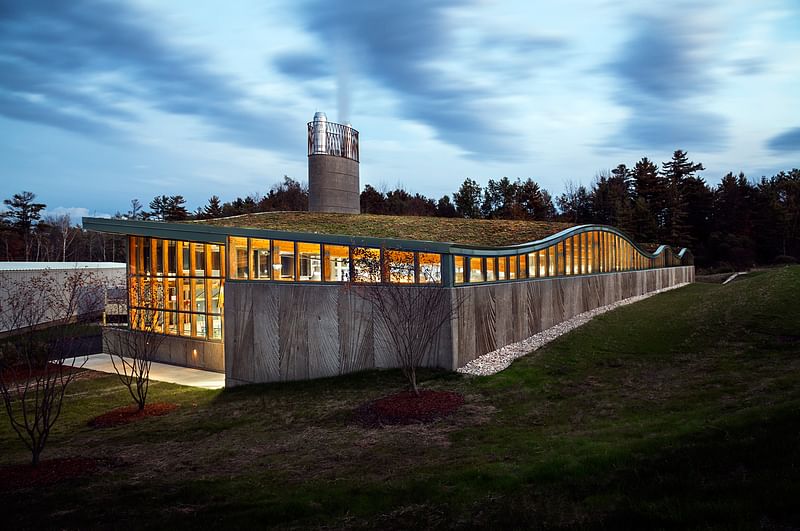
Green Building with Wood: Biomass Heating Plant, Hotchkiss School in Lakeville, CT
Architect – Centerbook Architects and Planners
Structural Engineer – DeStafano & Chamberlain, Inc.
General Contractor – O&G Industries
Project description: "Located in the forests of Connecticut, the Hotchkiss School saw its location as an opportunity to utilize a responsible and economical resource while demonstrating real world lessons to its charges. Faced with the replacement of an aging fuel oil heating plant, the school chose to build a LEED-certified biomass facility that burns wood chips from sustainably managed forests nearby. Valued for its renewability and local abundance, wood was also used in the building’s construction. Wall systems include glued laminated timber, laminated veneer lumber, parallel strand lumber and Douglas-fir interior framing. The roof features glulam girders and beams with a metal deck. Interior walls include oriented strand board and wheat board, and railings are made from a variety of locally harvested species. Aesthetically, the design creates an iconic presence while merging into its natural setting. The facility is covered with a rolling vegetated roof that changes color with the season."
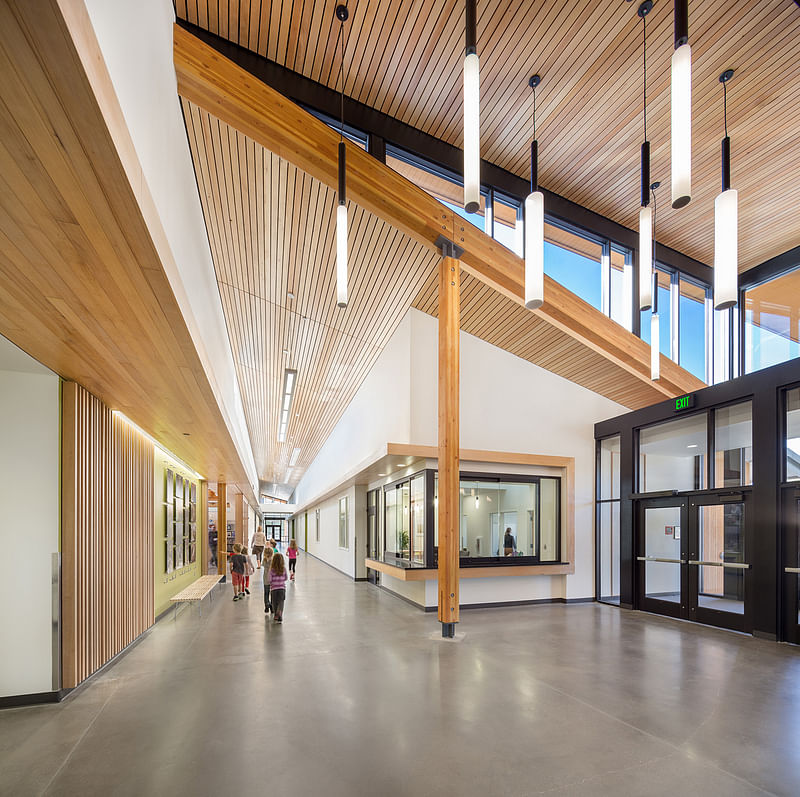
Wood School Design: Cascades Academy of Central Oregon in Tumalo, OR
Architect – Hennebery Eddy Architects, Inc.
Structural Engineer – Walker Structural Engineering, LLP
General Contractor – CS Construction, LLC
Project description: "Nestled among junipers, ponderosa pines and volcanic boulders, the Cascades Academy of Central Oregon is an independent school for pre-kindergarten through grade 12 students. The school is comprised of several wings forming a protected courtyard: the main wing with a commons, library, science labs and offices; upper and lower classroom wings; and a detached gymnasium. Exposed wood structure at select gathering spaces characterizes the school's focus on experiential learning in the natural environment. The building is clad in western red cedar arranged in vertical sections separated by glazing to reflect the rhythm of scattered junipers and pines while allowing views through the building and beyond to the surrounding desert landscape. Western hemlock is featured inside the building at ceilings, cable trays and screen walls to create a natural, healthy and inspiring setting for learning. Extensive use of wood allowed the design team to realize the project goals within the constraints of a limited budget and challenging schedule. In particular, the use of platform wood framing and pre-engineered wood trusses kept construction costs low."
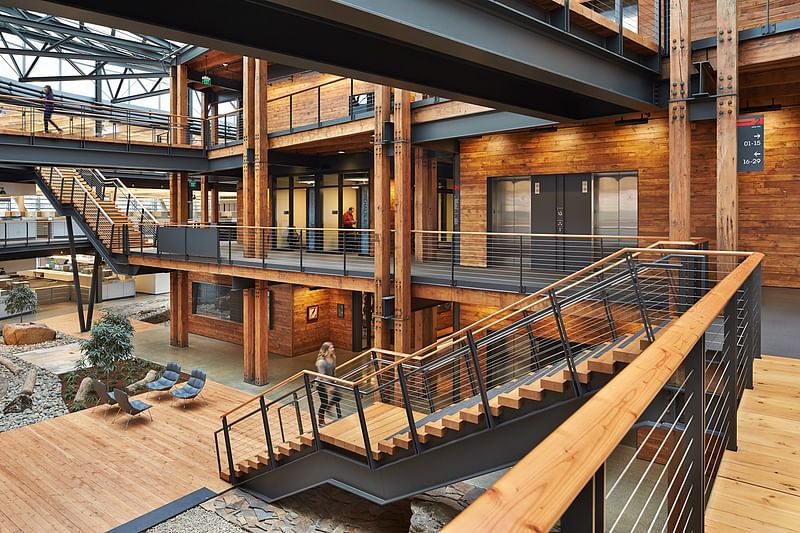
Commercial Wood Design: Federal Center South – Building 1202 in Seattle, WA
Architect – ZGF Architects LLP
Structural Engineer – KPFF Consulting Engineers
General Contractor – Stellan Construction
Project description: "Seattle District headquarters for the U.S. Army Corps of Engineers is a LEED Gold project which was partially funded through the U.S. General Services Administration’s Design Excellence Program, established to procure the nation's best engineers and architects in order to achieve the most innovative and high-performance design in federal government buildings. All of the wood used in the project was salvaged from a 1940s-era warehouse that previously occupied the site—a total of 200,000 board feet of heavy timber and 100,000 board feet of 2x6 tongue and groove roof decking. The heavy timber is featured fully exposed in the central commons, which includes conference rooms, libraries, restrooms and gathering areas. However, because the amount of reclaimed wood was limited, composite timber-concrete beams were also used to increase beam spacing and allow the entire program to be met with wood from the warehouse. Heavy timber was also used on the walking surfaces of interior pedestrian bridges and stairs, incorporated into the exterior entry canopy, and milled for use as hand railings and ceiling finishes, while reclaimed decking was also used for interior wall panelling."

Innovative Wood Engineering Promega Feynman Center, “The Crossroads” in Madison, WA
Architect – Uihlein‐Wilson Architects, Inc.
Structural Engineer – EwingCole
General Contractor – Kraemer Brothers
Project description: "The Crossroads, a client and staff reception area, is part of the Promega Feynman Center, a Good Manufacturing Practices (GMP) facility in Wisconsin. To contrast the GMP with a warmer aesthetic while meeting sustainability objectives, the design team chose a combination of glued laminated timber beams and a cross laminated timber (CLT) roof. The structure has a complex footprint, forming a sinuous S-curve that wraps around one corner of the rectangular GMP facility. The team was challenged to use a material that would perform well for the long-span deck needed to cover the curved roof—and CLT provided the solution. However, with virtually no square angles in the structure, beam-to-column connections were a challenge. To avoid more than 100 different configurations, the engineer designed a steel pin connector that allows as much as 10 degrees rotation in either direction, providing the required swivel to fit nearly all of the connections. Although CLT is relatively new to North America, the project earned local building department approval thanks in part to the new ANSI/APA Standard for Performance-Rated Cross-Laminated Timber. The design team discussed the standard with building officials, and submitted engineering information under the ‘alternate designs’ section of the International Building Code (IBC)."

Beauty of Wood: Reed College Performing Arts Building in Portland, OR
Architect – Opsis Architecture
Structural Engineer – KPFF Consulting Engineers
General Contractor – Hoffman Construction
Project description: "The Reed College Performing Arts Building is a vibrant 78,000-square-foot building housing the school’s theatre, dance and music programs. Designed to offer a social and creative environment, wood was used to create unique and welcoming spaces that invite students to explore, pass through and become immersed in a central commons where community is fostered. The atrium lobby features a three-story Douglas-fir wall crowned by a skylight providing an evolving show of shadow and light. Wood is also central to the building’s acoustic performance, with solid and perforated Douglas-fir wall panels and slat ceiling systems diffusing and absorbing sound in the atrium lobby and rehearsal hall. The studio theatre includes a red oak slat wall system made from a heritage tree that had fallen on the site during a storm. To improve student comfort, the dance studio and performance lab feature built-up sprung flooring made from plywood. The use of wood also helped the College meet its target of gold certification under the Earth Advantage green building program."

Jury's Choice Award: Habiframe, Inc. Tornado Storm Shelter in Memphis, TN
Architect – Habiframe, Inc.
Structural Engineer – Conestoga Rovers Associates, Inc.
General Contractor – Habiframe, Inc.
Project description: "When designing the 100-square-foot Habiframe, Inc. tornado storm shelter, the aim was to use existing products and technology to create a shelter that complies with the strict requirements of ICC 500–the 2008 standard developed by the International Code Council and National Storm Shelter Association. A structural preference for wood was driven by its strength, performance, durability and ease of construction. The desire to design a shelter that could be taken apart and relocated was also a critical factor for which wood met the challenge. The structure is made from laminated strand lumber and readily available connectors, screws and tie-rods. The first challenge was meeting the missile criteria for wind-borne debris, which can only occur through physical testing. The wall system passed the testing protocol with little to no damage resulting from debris impact. The second major challenge was load path continuity. The project design wind speed of 250 mph provided a significant amount of horizontal and vertical load to be resisted."

Multi-Story Wood Design: Bullitt Center in Seattle, WA
Architect – The Miller Hull Partnership
Structural Engineer – DCI Engineers
General Contractor – Schuchart Construction
Project description: "Described as the greenest commercial building in the world, the Bullitt Center pushes the envelope in urban sustainability. The six-story, 52,000-square-foot structure is designed to meet stringent requirements of the Living Building Challenge (LBC)—using photovoltaic cells to generate enough electricity to sustain the needs of its tenants, recycling its own water and waste, and reducing energy use by more than 80 percent compared to an average office building. The building includes four stories of Type IV, heavy timber-frame construction over a two-story concrete podium and the frame is comprised of Douglas-fir glulam beams and columns, finished to an industrial appearance grade. The design team had expected to use a reinforced concrete frame because they thought they needed it for thermal mass. But when they considered the embodied energy and carbon footprint of the concrete, timber turned out to be a better environmental solution. To let in as much natural light as possible, the design required high ceilings and tall windows. The architect chose 2x6 lumber set on edge and nailed in place to create relatively shallow solid wood floor panels, which helped to increase daylight penetration."
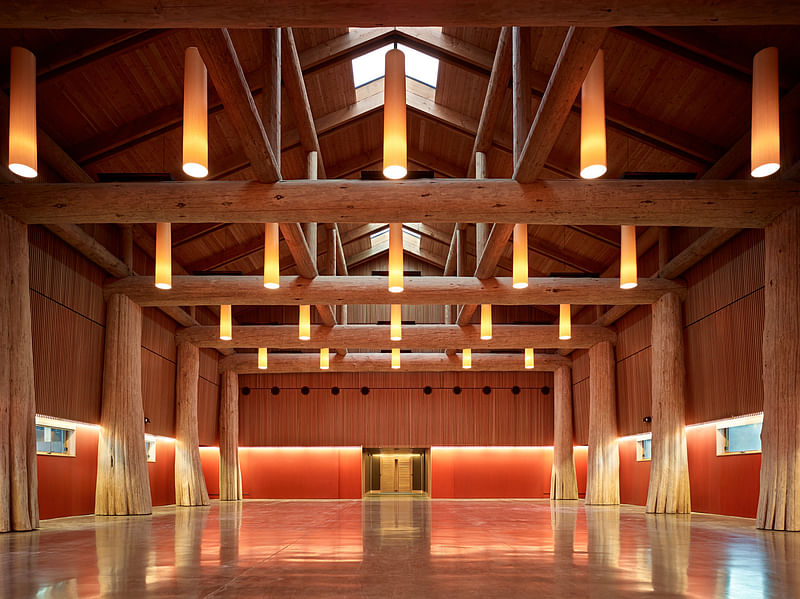
Traditional Use of Wood: Muckleshoot Smokehouse in Auburn, WA
Architect – Mahlum
Structural Engineer – PCS Structural Solutions
General Contractor – Donovan Brothers, Inc.
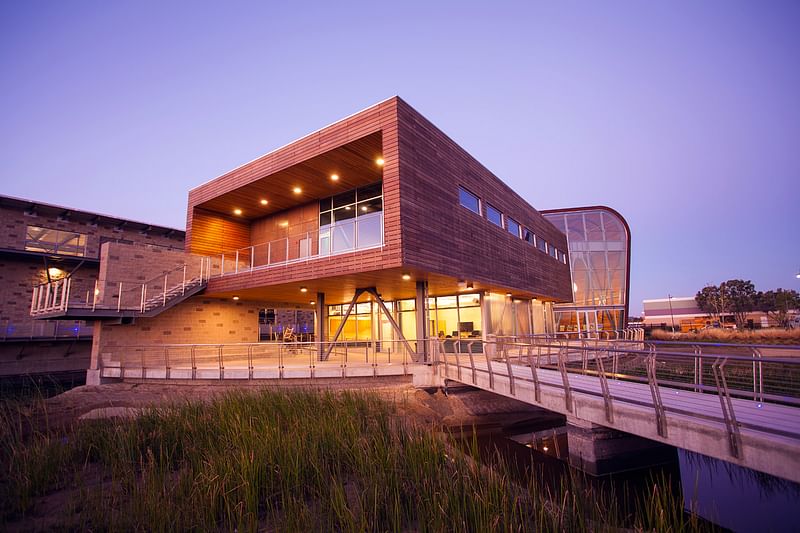
Regional Winner: Advanced Water Purification Facility in Oxnard, CA
Architect – Mainstreet Architects + Planners Inc.
Structural Engineer – CH2M Hill General
Contractor – McCarthy Buildings
Project description: "The Advanced Water Purification Facility’s 11,600-square-foot Science and Administration Center serves as the public entrance for tours of five separate process-oriented facilities as well as a walk-through tour of the site’s interactive demonstration wetlands. Wood offers a harmonizing counterpoint to the site’s industrial buildings and brings a human scale to the project while providing warmth and texture. Western red cedar was used for the exterior ‘rainscreen’ assembly and entry portal, and as an interior finish on walls, ceilings and soffits. As a natural, renewable resource, it was also the perfect backdrop for visitors learning about the importance of water conservation and resource recycling."

Regional Winner: Manhattan Fire House #3 in Manhattan, KS
Architect – Action Pact Design
Structural Engineer – BSE Structural Engineers
General Contractor – Murray and Sons Construction Co. Inc.
Project description: "For Manhattan Fire House #3, designers chose wood in order to meet the project’s environmental performance objectives and ensure the project was constructed easily and quickly. To create a thermally-efficient building envelope, the design team chose six-inch Structural Insulated Panels, or SIPs, for the exterior walls. Since the post- and-beam construction was exposed in the interior, the team selected parallel strand lumber columns to create a more welcoming indoor environment for the 9,250-square-foot fire house which also serves as a training center."
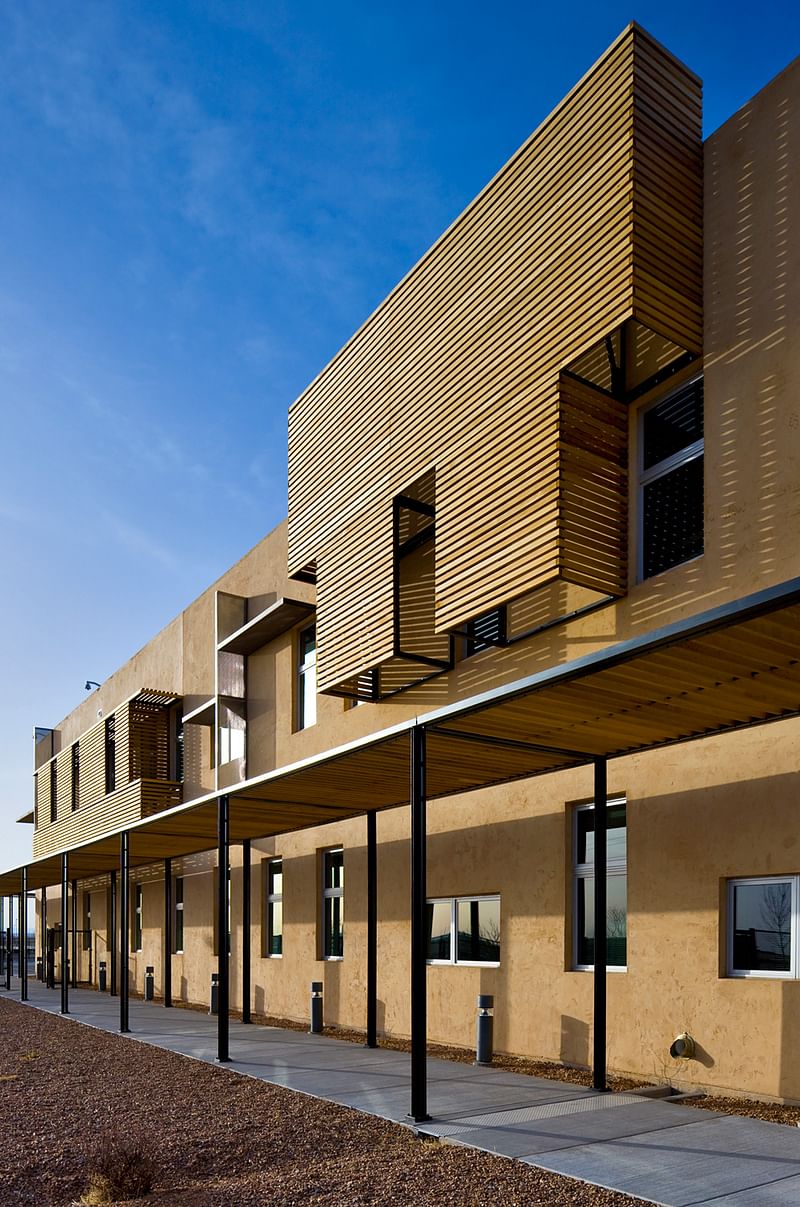
Regional Winner: GSA Office Building in Albuquerque, NM
Architect – Page Southerland Page, LLP
Structural Engineer – Walter P. Moore & Associates
General Contractor – Enterprise Builders Corporation
Project description: "Situated on a broad mesa in New Mexico, this 80,000-square-foot GSA office building is constructed from masonry in order to take advantage of the high diurnal temperature swings of the desert. However, the use of such a visually heavy enclosure system necessitated the introduction of a lighter material. Western red cedar was used to shade the windows from the desert sun and provide visual interest across the long building facades. The trellis provides shade for visitors and frames the mountain views. In the courtyard, wood was selected for its stress-reducing qualities—a boon for a building which houses immigration facilities where both immigrants and officers face challenging situations. The courtyard is located in the center of the structure and provides a shaded, protected oasis where visitors and employees can relax throughout the day. It is extensively shaded by a series of cable-supported transverse wood slats that are variably spaced to provide sun shading only where necessary—along the east, west and north courtyard facades. The GSA office building achieved LEED Silver certification."
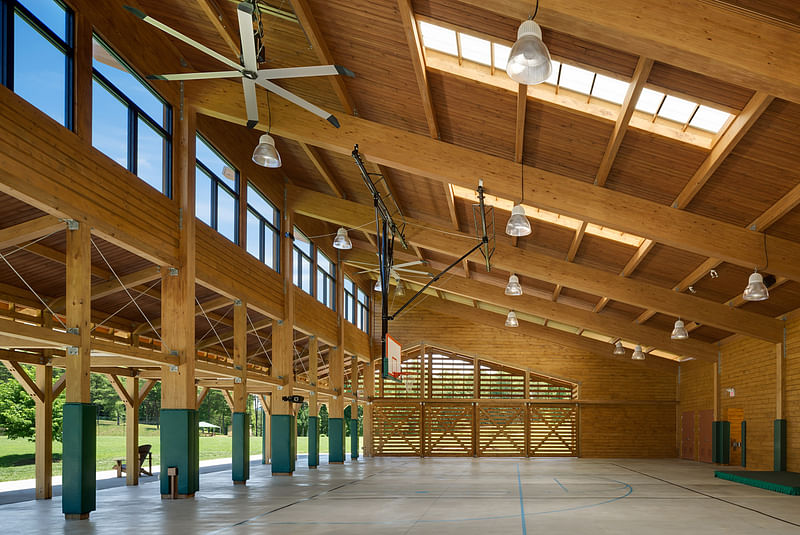
Regional Winner: YMCA Pavilion at Camp Harrison in Boomer, NC
Architect – C design Inc.
Structural Engineer – Fitzpatrick Engineering
General Contractor – David E. Looper&Company
Project description: "Camp Harrison needed an open-air pavilion full of natural light to provide an activity and gathering venue for itscampers. The 8,000-square-foot program includes an open-air pavilion, covered recreation space, restrooms and storage room. In order for the interior to be completely protected from rain, it was designed with three open sides while the fourth side features an optional barn door closure. The team maximized the expansive views by situating the pavilion facing the lower sports fields and mountains beyond. Wood was selected for this project to maintain the camp vernacular, which consists primarily of log and heavy timber construction. The design of the pavilion resembles a stable in reference to the camp’s active equestrian program. It also follows the innovative design and programming of an award-winning heavy timber pavilion at YMCA’s Camp Thunderbird, which has been exceptionally well received."

Share
0 Comments
Comment as :